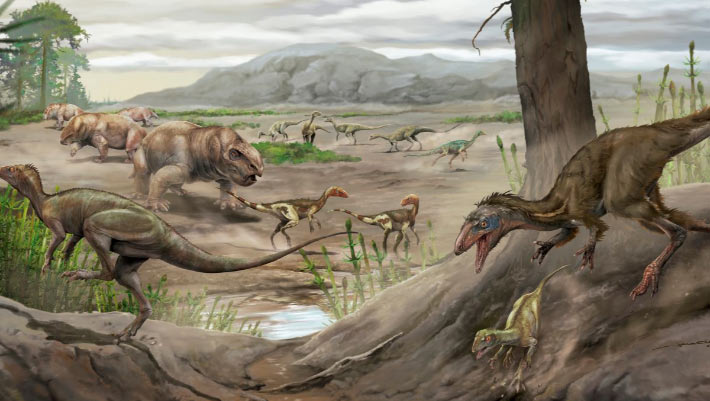In a groundbreaking discovery from Patagonia, Astigmasaura genuflexa, a previously unknown species of rebbachisaurid sauropod, was unearthed by paleontologists. This new species offers invaluable insights into sauropod evolution during the Late Cretaceous period, specifically around 95 million years ago. The fossil was found in the El Orejano locality of the Huincul Formation, located in the Neuquén Basin of Argentina. According to the original study published on ScienceDirect, this discovery sheds light on the evolutionary journey of sauropods in Gondwana, particularly within the Rebbachisauridae family.
This monumental find is more than just the discovery of a new species. It opens new doors for understanding the diversification of sauropod dinosaurs in South America, a region crucial for the fossil record of the Cretaceous period. By examining the Astigmasaura genuflexa remains, researchers are piecing together the evolutionary puzzle of sauropod dinosaurs, which have long intrigued paleontologists.
The Significance of Astigmasaura Genuflexa in Sauropod Research
The recently discovered Astigmasaura genuflexa lived during the Late Cretaceous, at a time when sauropods were one of the dominant herbivorous groups on Earth. Paleontologists found a partial, articulated postcranial skeleton of a single, morphologically adult individual of Astigmasaura. This specimen was an enormous creature, measuring about 18 meters (59 feet) in length and weighing over 10 tons. The discovery fills a critical gap in the Rebbachisauridae fossil record, a group of sauropods that is crucial to understanding the diversity of plant-eating dinosaurs during the Cretaceous period.
This new species contributes to an understanding of the anatomical features of Rebbachisauridae, a family known for having highly specialized skulls, pneumatized axial elements, and gracile appendicular skeletons. According to the paleontologists, “Rebbachisaurids are medium to large-sized, non-selective and ground-level browser diplodocoid sauropods, and they are characterized by highly specialized skulls, widely pneumatized axial elements and gracile appendicular skeletons.” This discovery not only uncovers the unique features of Astigmasaura genuflexa, but also expands our knowledge of sauropods in Gondwana, particularly in Patagonia.
Rebbachisaurids in Gondwana: An Evolutionary Hotspot
The Rebbachisaurid family’s fossil record spans from the Early Cretaceous to the early Late Cretaceous, with a particularly rich diversity in Gondwana, the ancient supercontinent that later split into Africa, South America, and other regions. The findings in Patagonia are especially significant, as they represent a hotspot for rebbachisaurid fossils. As noted by the researchers, “Known from the Early Cretaceous to the early Late Cretaceous, the rebbachisaurid fossil record is particularly diversified in the ancient supercontinent Gondwana, with several specimens found in North Africa and South America.” This supports the idea that Gondwana was a crucial center for sauropod evolution, offering important evidence of how these massive creatures adapted to different environments across the continent.
Patagonia has been particularly rich in sauropod fossils, with the region yielding over half of all known Rebbachisauridae specimens. This includes some of the earliest forms of rebbachisaurids, as well as the youngest specimens found to date. As a result, Patagonia has become one of the most important regions for understanding the evolution of this family of dinosaurs. The discovery of Astigmasaura genuflexa further enhances this narrative, suggesting that the evolutionary history of Rebbachisauridae in this region is far more complex and diverse than previously understood.
Uniqueness of Astigmasaura Genuflexa
One of the key features that set Astigmasaura genuflexa apart from other sauropods is its distinct combination of skeletal features, which have never been observed in any other known sauropod species. “Astigmasaura genuflexa shows a unique combination of diagnostic features that distinguish it from all other sauropods,” the researchers pointed out. These features include anterior caudal vertebrae with tall neural spines and tetraradiate neural laminae, asymmetric middle haemal arches, and mediolaterally compressed proximal tibiae. The femur, another key bone, displays medially inclined distal condyles, setting Astigmasaura apart from other sauropods in the family.
Furthermore, the fossil provides new morphological information regarding the caudal (tail) and pelvic girdle anatomy of Rebbachisauridae—areas that have remained poorly understood until now. As the paleontologists mentioned, “This new record not only provides new morphological information about the caudal and pelvic girdle anatomy of Rebbachisauridae, which is poorly known to date, and suggests a greater taxonomic diversification within the family during the last stages of its evolutionary history than known before.” This insight is invaluable for paleontologists studying the later stages of sauropod evolution and the different adaptations that emerged during the Cretaceous period.
Source link


